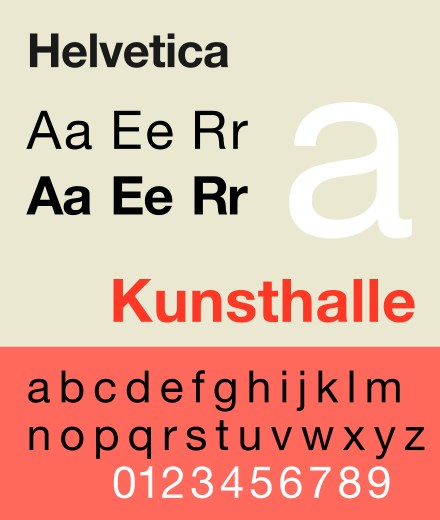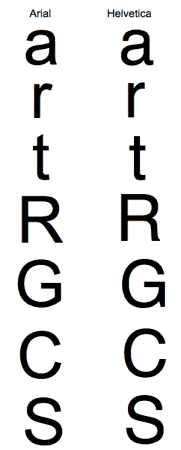
Helvetica is a widely used sans-serif typeface developed in 1957 by Swiss typeface designer Max Miedinger with input from Eduard Hoffmann. His objective was to create a neutral, legible sans serif typeface. Its original name was Neue Haas Grotesk and is a neo-grotesque or realist design, one influenced by the famous 19th century typeface Akzidenz-Grotesk and other German and Swiss designs. Its use became a hallmark of the International Typographic Style that emerged from the work of Swiss designers in the 1950s and 60s, becoming one of the most popular typefaces of the 20th century.
Arial was originally known as Sonoran Sans Serif and became to be known as Arial after its inclusion in Windows by Microsoft. Monotype currently owns the copyright for Arial.
Notable features of Helvetica as originally designed:
- The termination of all strokes on horizontal or vertical lines
- unusually tight letter spacing, which give it a dense, compact appearance
Compared to Arial
Helvetica and Arial share many similar characters but some characters are different. The Differences lie in small details.
The a in Helvetica has a tail while Arial does not. The bowl of “a” flows back into the stem like “s” in Helvetica, where as the bowl is intersected with a slight curve in Arial.
The top of “t” is cut off at angles in Arial whereas in Helvetica “t“ has straight cuts. The end strokes of “S” and “C” are horizontal in Helvetica while in Arial they are at an angle.
“G” in Arial has no spur at bottom and curve meets the stem at an angle. The “G” in Helvetica has a spur at bottom of stem and the curve at bottom flows into the stem.
In Arial “R” the tail flows down and to right from center and straightens out at an angle to the end. The tail of “R” in Helvetica flows out from center, curves straight down and ends in a slight curve to the right.
Arial contains more humanist characteristics than Helvetica.
Arial is a more rounded design than Helvetica, with softer, fuller curves, and more open counters. The ends of the strokes on letters such as ‘c,’ ‘e,’ ‘g,’ and ‘s,’ are terminated at the more natural angle in relation to the stroke direction giving it a less mechanical appearance than Helvetica, which has straight cuts on the horizontal.
Neither Arial or Helvetica are not the most legible typefaces because — like many sans serif typefaces — they have indistinguishable capital i and lower case L. One example cited by designer Viljami Salminen in his article Typography for User Interfaces is the word “illiterate”.
The word “illiterate” is hard to read when in Helvetica compared with Source Sans Pro. Illustration by Viljami Salminen.




